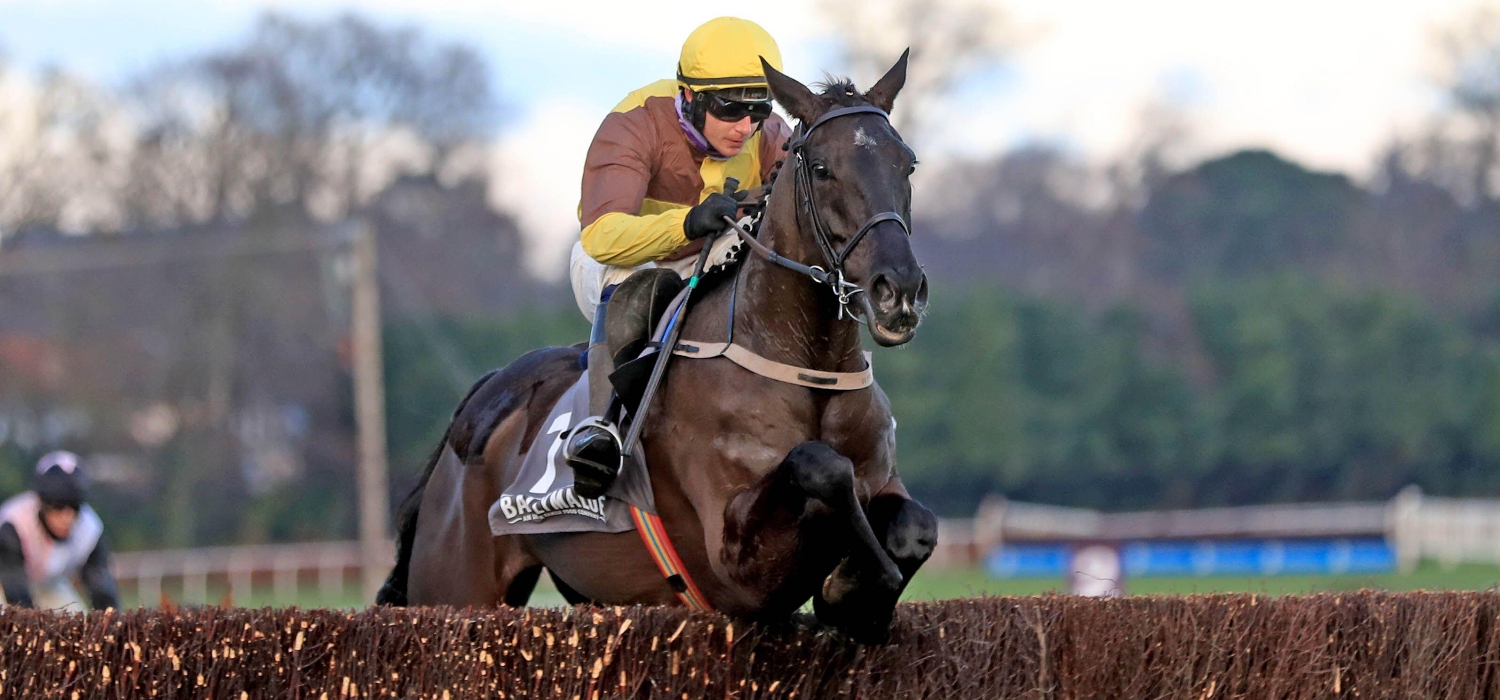
Cheltenham Trends expert Matt Tombs will be previewing different types of races on Tuesdays leading up to the Festival.
He covers the four novice chases this week…
4 Level-Weights Novice Chases Rather Than 2
Until 2010 the Arkle and Broadway were the only 2 level-weights novice chases. In 2010 the penalties in the 4-Miler were removed. In 2011 the Turners was introduced. The best horses have become concentrated in fewer hands so there’s more incentive, as well as opportunity, for the best horses to avoid each other.
The consequent dilution has significantly reduced the competitiveness of the novice chases.
Field sizes have shrunk – especially in the specialist 2m division. Before the Turners was introduced the average Arkle field this century was 13.6, since then it has been 8.4. In the Broadway, it’s dropped from 12.3 to 10.3.
Very few horses run who wouldn’t have when there were only 2 level-weights novice chases. Those horses are now spread between the 3 Grade 1s, with a few going for the Not-Quite-4-Miler who wouldn’t previously have tried to defy the penalties.
That’s crucial when profiling the 4 novice chases and looking at trends. The inherent nature of the Champion Chase & Gold Cup haven’t changed much and so trends based on the 21 renewals this century work well. In the novice chases it’s necessary to focus more on recent renewals.

With Ferny Hollow out for the season, Blue Lord is favourite to win the Arkle after his win at the Dublin Racing Festival over the weekend.
Predictableness
An unsurprising consequence of the dilution is that the races have become much more predictable. A broad generalisation is that the longer a conditions race chase the less predictable it is – that’s the case with the 4 level-weights novice chases.
2m chasing is the most specialist division and the Arkle has been the race to suffer most from the dilution. Before the Turners was introduced in 2011 no horse had gone off odds-on for the Arkle since 1993.
In 7 of the last 10 Arkles there has been an odds-on favourite and they’ve all bolted up.
With Ferny Hollow out it may be shaping into a sub-standard renewal. That makes it more open but only 2 winners this century went off double-figure prices so the front of the market remains the place to focus on.
Whilst the only odds-on shot in the Turners, Envoi Allen, fell last year, 10 of the 11 winners went off single figure prices and the front of the market has been the place to look. Bob Olinger and, if he runs, Galopin Des Champs look to justify their short prices.
The uncertainty of getting into a rhythm and the advantage of being battle-hardened over fences has made the Broadway less predictable than the Arkle.
Surprises were fairly common with 26.0 & 34.0 winners in the early part of the century but with the fields diluted now, 4 of the last 7 favourites have gone in with all those 7 renewals going to the front 3 in the market. The likes of Ahoy Senor & Capodanno look like potential shorteners, especially if some of the market leaders defect to the Turners or Not-Quite-4-Miler.
The Not-Quite-4-Miler is the least predictable, the last winning favourite was Back In Focus in 2013. Only 2 winners this century had run beyond 3m2f and there is very little form at that sort of race distance.
Cheltenham Ante-Post Previews:@thespieler joins @DanielHussey2 & @mdeasy85 to give us his thoughts on the Cross Country 🙌
"I can see him being heavily backed in the last week or two"👀
𝗪𝗮𝘁𝗰𝗵: https://t.co/oJP6WmNZVM 📺 pic.twitter.com/yhTk25Dmjm
— Matchbook Betting Exchange (@TeamMatchbook) February 8, 2022
Different Qualities Needed At Different Trips
The qualities needed in chasing vary considerably depending on the race distance. They apply to almost any chase but are particularly useful in betting on novice chases where we know less about the horses.
Good horses rarely finish tired over 2m. Raw speed is crucial as few horses can run quickly and then jump at an Arkle gallop.
Gaining track advantage by standing off outside the wings can be a good use of energy – it’s hard to make up ground in an Arkle. Whilst her tendency to jump right is a slight concern over the turning Old Course, Riviere D’etel’s bold jumping is well suited to the minimum trip.
By contrast, in staying chases, the energy used making such prodigious leaps is usually better kept for the business end when even good horses are tiring, (especially if the horse is reined back after making that ground.) Bravemansgame has the ideal jumping technique for a Broadway.

 Bet Now
Bet Now
Inherent Class vs. Chasing Experience
Every day, punters have to balance class and potential against experience. In the Festival novice chases, the shorter the trip the greater the emphasis on class, the longer the trip the more important chasing experience becomes.
In the Arkle class tells. Since the BHA began giving all runners ratings in 2008, 8 of the 14 top-rated horses have won (66% profit). Chasing experience has been less of a factor – this century Well Chief & Western Warhorse have both won off 1 chase start and Simonsig & Tiutchev have won off 2. If the likes of Haut En Couleurs & Saint Sam line up after only 2 chase starts that shouldn’t put you off.
By contrast, in the Broadway and Not-Quite-4-Miler, chasing experience has been the bigger factor. The only winner of either this century off only 2 chase starts was Don Poli. Willie Mullins has trained the last 2 Broadway winners off only 2 chase starts, (Florida Pearl being the other,) but I’d still have that as a negative for Galopin Des Champs if he runs in the Broadway.
Lots of chasing experience has been especially important in the Not-Quite-4-Miler with 6 of the 12 level-weights renewals won by horses with 8+ chase starts.
With 5 of the 14 150+ rated runners at level-weights winning, (159% profit,) Run Wild Fred, (rated 158 after 10 chase starts), has a better profile than Stattler who looks set to line up after just 2 chase starts.
Getting Over Fences Quickly
Every horse needs treating individually, but if you want a Grade 1 chaser it’s a big advantage to go chasing quickly. Plenty of horses spend their prime in bumpers/hurdles and come to chasing too late. That’s especially the case in the staying division where they’ve often had a lot of tough races before having to adapt to regulation fences.
In the specialist 2m division raw speed counts and high-class hurdlers in open company such as Moscow Flyer, Sizing Europe & Un De Sceaux have made the transition and won the Arkle.
Edwardstone wasn’t in their class over hurdles, consistently beaten off marks in the 140s, and may not have enough basic toe.
By contrast, the last Broadway winner to have had 2 full seasons over hurdles was Young Hustler in 1993. That’s a negative for Fury Road & Beacon Edge if they run in the Broadway.

Bob Olinger is the current favourite to win the Turners and make it back-to-back Cheltenham Festival wins
Festival Form
In 2011, when Al Ferof went over fences the autumn after winning the Supreme he was the first to do so for 30 years and First Lieutenant was only the third Ballymore winner to do so since the 1980s.
Since then its become more the norm than the exception with Douvan, Altior & Shishkin all following up their Supreme wins in the Arkle and Vautour doing so in the Turners. Simonsig followed up his Ballymore win by winning the next Arkle and Yorkhill followed up in the Turners.
Appreciate It’s setback has meant chasing has been shelved but Blue Lord would have finished second in the Supreme if he’d stood up and has fair claims in a weak-looking Arkle. Ballymore winner Bob Olinger isn’t the quickest away from his fences but his tactical speed should be a big weapon in the Turners.
First of a series profiling different festival races, and the trends that flow out of that
Hopefully some pointers in the way of ante-post value before the championship race markets get efficient closer to the festival
Good luck! https://t.co/QfkRt0Pzw4
— Matt Tombs (@thespieler) February 1, 2022
Turning to a specific trend for each race:
Arkle
5-y-o had a good record when benefiting from a weight-for-age allowance. Between 1998 & 2007, in receipt of between 4lb and 8lb, they were 4/26, (46% profit). The allowance was abolished in 2008 and since then all 8 5-y-o have been beaten, (4 of which went off in the front 2 in the market). That’s a statistical negative for Haut En Couleurs, Saint Sam & Riviere D’etel who have been benefiting from the allowance so far, although the older novices don’t look strong this year.
Turners
Intermediate trip races are still the poor relations and novices often run in the Turners after connections have established they aren’t good enough for the Arkle or Broadway. Grade 1 chase form at around 2m or 3m, even in defeat, is often stronger than at intermediate trips, but tends to be under-bet. Horses that had finished in the first 3 in a Grade 1 chase at around 2m or 3m are 5/23 (80% profit). If Saint Sam, Bravemansgame or Fury Road were to run here they could be underestimated.
Broadway
Grade 1 chases over 3m+ are generally tough contests. Horses unbeaten in chases tend to get over-bet on potential, and those that haven’t been tested over fences often fail through not being battle-hardened enough. Unbeaten chasers are 3/33 this century. Those 3 were the great Denman and also Monkfish & Don Poli who won arguably the weakest renewals this century. Galopin Des Champs hasn’t really been tested so far over fences and that’s a concern if he lines up in this.
Not-Quite-4-Miler
The spectrum of assistance from the saddle is much wider in the amateur rider races and jockeys are crucial. The top amateurs have dominated with Jamie Codd (3), Derek O’Connor (2) & Patrick Mullins (2) winning 7 of the 11 amateur ridden renewals at level-weights. There’s ante-post value if you can work out what they will ride. Run Wild Fred (Codd) & Stattler (Mullins) are well found in the market but assuming Capodanno doesn’t run O’Connor is free and whatever he rides is likely to collapse in price.
If you’re looking for more Cheltenham content, Matt Tombs joined Daniel Hussey and Micheál Deasy for a look at the Brown Advisory Novices’ Chase specifically.
Watch Our Latest Cheltenham Ante-Post Preview:
Subscribe to the Matchbook Betting Podcast here
Subscribe to the Matchbook YouTube Channel here
Check out our Cheltenham YouTube Playlist here








